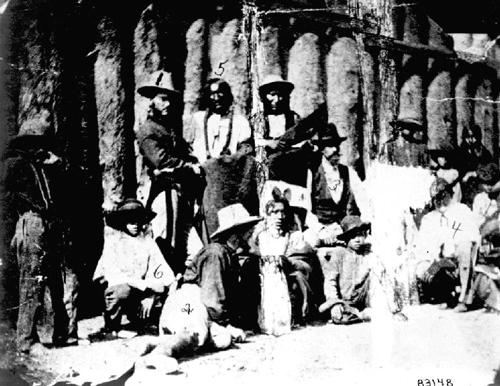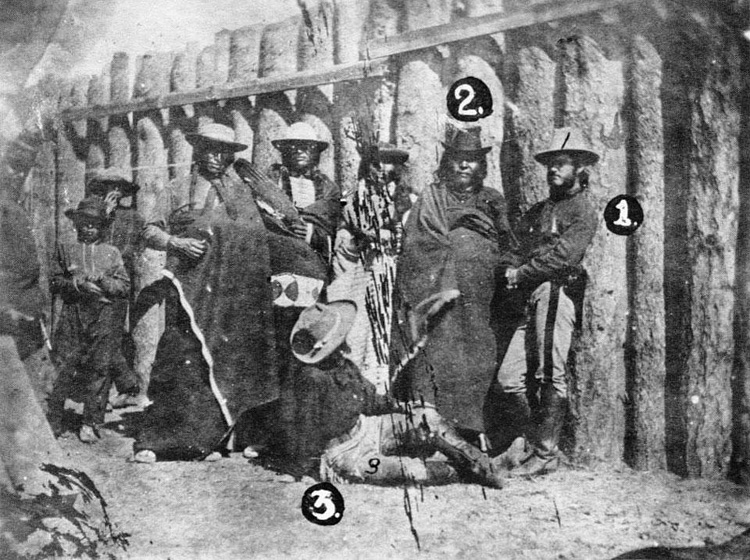Red
Leaf did go to Washington just the once, with the Red
Cloud Agency delegation in May-June 1872. That plantation
owner's fan, or in any case one like it, turns up in one
or two 1872 images (I'm thinking of the shot of Slow Bull
kneeling, obviously cropped from a group portrait). But
Red Leaf isn't included in the classic Alexander Gardner
series of portraits done in 1872. —
Kingsley Bray

[Stanley]
Morrow made a visit down to the new Spotted Tail Agency
in 1878 (I think), before the agency was moved one final
time to become the Rosebud Agency. I suspect that some
of Morrow's Brule images, including the one of Red Leaf
in his blanket, were taken at that time, but I have no
confirmation yet. — Ephriam
Dickson

Red
Leaf was born about 1815, and he crops up in one of the
Rosebud Agency censuses, maybe 1886 or '87 (with a 30 year-old
wife!), but I can't find him after that. Perhaps Ephriam
can help with his census data.
He
was a presumably younger brother of Scattering Bear (Mato
Wayuhi - I've had wayuhi explained as like a bear digging
in the earth and scattering roots). They belonged to one
of the leading families within the Wazhazha band, a large
tiwahe with very extensive connections. As early as 1844-45
trader David Adams considered Scattering Bear as the leader
of one constituent sub-band of the Wazhazhas. SB dealt
directly with Adams and rival traders as the 'chief' of
this group. In January 1846 a group of Brule chiefs -
they seem largely to be Wazhazhas - signed a petition
to be presented to the President, requesting recompense
for the loss of resources to the emigrant traffic along
the North Platte River. Scattering Bear was signatory
no. 1.
In
1851 SB was selected by treaty commissioner David Mitchell
as the head chief of the Lakotas during the councils for
the Horse Creek Treaty. The council of Lakota leaders
then validated Mitchell's choice, and SB - reluctantly
- agreed to act as the principal intermediary between
Americans and the Lakotas. Red Leaf during this period
is unmentioned in the sources, but it is likely that he
was one of his brother's aides - I suspect the Lakota
term would be kolaya. He may have served as an akichita
or police officer. After the killing of his brother in
the Grattan fight of 1854 Red Leaf and several kinsmen,
inluding brother Long Chin and cousin Spotted Tail, avenged
the death in the mail coach raid of November 1854. In
the fallout from this raid, the Wazhazha band council
- temporarily united around a peace agenda under the headman
Stabber - drove out Red Leaf and his adherents. With 26
lodges of Wazhazhas (about one third of the whole band)
they were part of the camp attacked by Harney at the Blue
Water in Sept. 1855. The surrender of the mail coach raiders
was one of Harney's demands for peace, and after prolonged
negotiations run by Agent Twiss and the peace party Lakotas,
Red Leaf, Long Chin, and Spotted Tail surrendered in October.
They were sent to Ft Leavenworth for several months in
the winter. President Pierce pardoned them in January
1856, and they shortly were moved to Ft Kearney on the
Nebraska frontier, where they stayed throughout the spring
and summer of 1856.
After
return (Sept. 1856) to the Brules, Red Leaf was selected
as the band chieftain (Wichasha Itanchan) of the Wazhazhas.
Reading and hopefully not over-reading Woman Dress statement
to JR Walker, I suggest he was taken into the Brule chiefs
society (Nacha Okolakichiye). He did not succeed to his
brother SB's unique position as head chief (Billy Garnett's
account inidicates that the dying SB had passed it on
to Man Afraid of His Horse of the Oglalas - a case of
a poisoned chalice?). He remained the most widely influential
Wazhazha leader through the next generation. One thing
I've detected in council proceedings is how often Wazhazha
spokesmen were younger men - Red Leaf spoke comparatively
rarely. Far from being a symptom of weakness, I suggest
that Red Leaf's tactic of engaging the rising men was
a successful strategy. How else explain the almost unprecedented
growth in the Wazhazha band - eighty lodges in 1854 (about
500 people), to just under 200 by 1875. This means that
people from other bands were attracted to join the Wazhazhas.
There was quite a spurt during the Bozeman Trail war period
- reflecting Wazhazha involvement in the profitable stock
raiding - but it continues right into the years that the
band settled at Red Cloud Agency (1871-77), when Red Leaf's
leadership continued to attract new adherents. Chiefs
with bigger names today - Red Cloud, Man Afraid of His
Horse, Little Wound, and so on - couldn't match this -
so our friend RL was 'doing something right'.
The
1887 Rosebud census is now online at the Oyate Research
Center website. I just rechecked there and under Wazhazha
band we find the following family:
Red
Leaf, Husband, Age 72
Fight all the Time, Wife, 30
Look Good, Daughter, 8
Little Girl, Daughter, 6
Foot Son, 2
This
suggests that Red Leaf's youngest wife married the chief
about 1877 or 78 (possibly linked to the move from Red
Cloud to Spotted Tail Agency in April 1877?), and their
eldest child was born a year or two later. —
Kingsley Bray

Here
is another photograph of Red Leaf. Probably he is also
in the second photograph of the same session (standing
far left with hat):

Below:
1. Lt. Carter 2. Tavernier 3. Dear (indian trader) 4.
Lt. Buchanan 5. Red Leaf

—
Dietmar Schulte-Möhring

The
1874 photographs [above] were taken by Lieutenant Thomas
Wilhelm, 8th Infantry, in the spring of 1874, shortly
after the establishment of Camp Robinson and Camp Sheridan
near the White River agencies.
Wilhelm,
who was adjutant for the 8th Infantry and an amateur photographer,
requested permission to visit the agencies where several
companies of his regiment were stationed. He traveled
with artist Jules Tavernier from Cheyenne to Fort Laramie,
then to Fort Fetterman, and finally to Camp Robinson,
accompanying Captain Stanton, the department paymaster
(since travel in this region was very dangerous during
this time).
Two
people were most instrumental in helping Wilhelm obtain
photographs. James W. Dear, one of two Indian traders
at Red Cloud (his store was located on the west side of
the agency; Frank Yates, brother of Captain Yates 7th
Cav, operated the store on the east side) made introductions.
Also Lieutenant William H. Carter, also a member of the
8th Infantry, helped.
The
two tintypes were taken inside the compound or corral
of J. W. Dear's store at the Red Cloud Agency (not at
Camp Robinson -- remember, did not become known as Fort
Robinson until 1878). You will notice that one of the
images is reversed -- as happens in some tintypes depending
upon the type of camera. Wilhelm presented both of these
images to Lieutenant Carter in appreciation for his assistance;
Carter later donated them to the National Archives along
with his life-time collection of military memorabilia.
All of the copies you see, credited to the Nebraska State
Historical Society and elsewhere, are just copies of the
original two tintypes at the National Archives.
— Ephriam Dickson